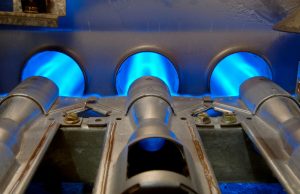Furnaces are designed to last decades without major problems so long as they are regularly maintained. They typically work so well, in fact, there is a danger of taking our comfort for granted and skipping the annual service for a year or two as time rushes by, waking up suddenly to a dark night and no heat.
In retrospect, a preliminary indication of trouble could have been the furnace continually turning off and on in short bursts, something that was tugging at your senses, but not strongly enough to really catch your attention.
Possible Problems
Your Salt Lake City furnace constantly turning on and off could often be a direct result of poor airflow through the system. Heat builds up and the detectors sense the proper temperatures have been reached and automatically shut down. In the room, the thermostat calls for more heat and starts the cycle over again.
A relay switch or control valve may also be worn and working improperly. A crack in the heat exchanger might fuel the flame to burn too hotly and cause the sensor to misinterpret the information and shut down.
These problems not only impede the distribution of heat to the living spaces, decreasing comfort, but also create intense wear on the motor and controls, threatening the very life of the appliance.
Simple Solutions
Restricted airflow can be caused most often by a dirty or clogged filter. At the furnace, there is usually a panel that can be removed to check, clean or replace the filter. It is typically a single or series of cardboard and screen panels approximately 1′ by 2′, but varies by manufacturer and furnace output.
A vacuum to pull lint free or compressor to blow it clean are the recommended tools to use a few times each year. It is a good idea to change the filters at the beginning of each heating season. The belts are also easily replaced.
The fan belts for the blower may also be worn loose and not pushing the air hard enough to get through the filters. It is a good idea to check them regularly as well.
Annual Maintenance
When in doubt, call the experts out. Scheduling an annual inspection and service with Salt Lake City HVAC professionals Design Comfort takes the worry out of living in a furnace heated home. Besides the rite of safe passage for your peace of mind, trained mechanics can spot the defects and give you the best assurance of a long life of comfort and warmth.
Continue Reading
Tags: Furnace Repair, Furnaces, Heating, Salt Lake City
Posted in Heating | Comments Off on Heating Tip: What To Do If Your Furnace Keeps Turning On or Off?
 It doesn’t mean anything good. No, your furnace is probably not going to explode. In fact, that’s not at all what’s going to happen. But a booming furnace, or a noisy furnace period, is a definite sign that you’re in need of a professional furnace repair in Salt Lake City, UT.
It doesn’t mean anything good. No, your furnace is probably not going to explode. In fact, that’s not at all what’s going to happen. But a booming furnace, or a noisy furnace period, is a definite sign that you’re in need of a professional furnace repair in Salt Lake City, UT.
 With winter winding down but temperatures still keeping our furnaces on full-force for now, it’s the perfect time to take care of any small repair needs that might have cropped up, so that you’ll know your heater is fully functional for next year. Functionality is just part of the equation, however. You want to ensure your furnace is safe, too.
With winter winding down but temperatures still keeping our furnaces on full-force for now, it’s the perfect time to take care of any small repair needs that might have cropped up, so that you’ll know your heater is fully functional for next year. Functionality is just part of the equation, however. You want to ensure your furnace is safe, too.
